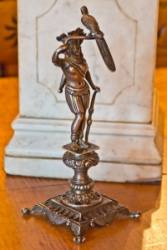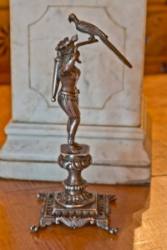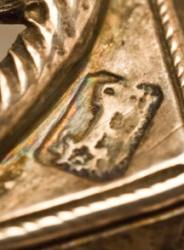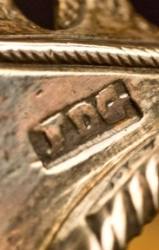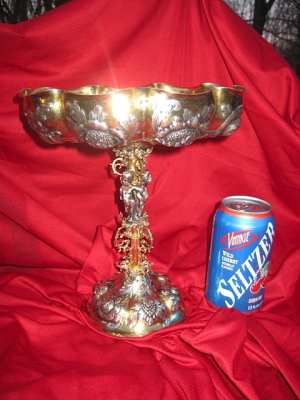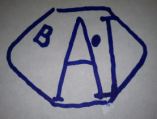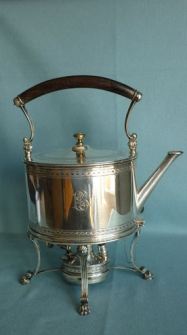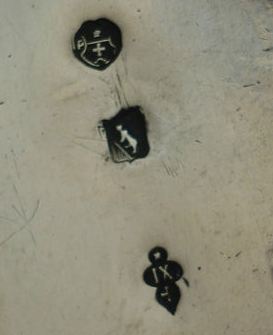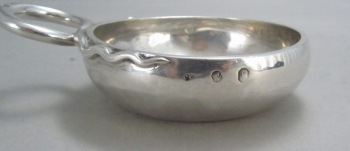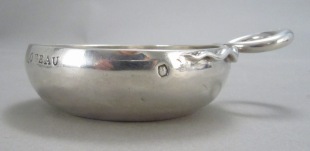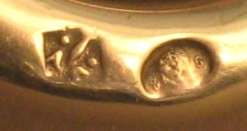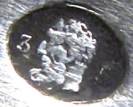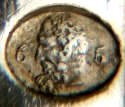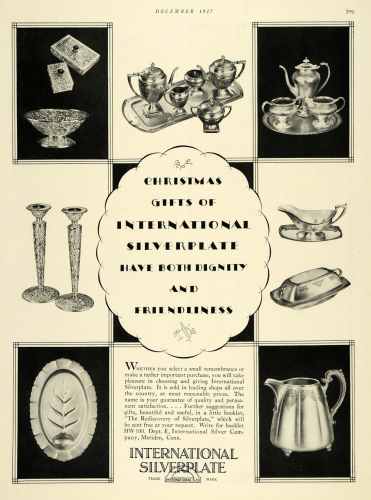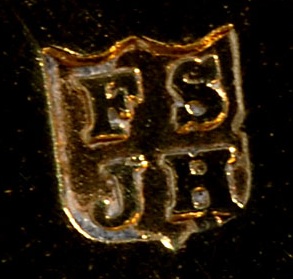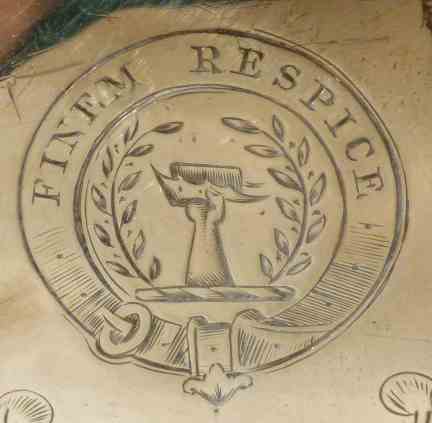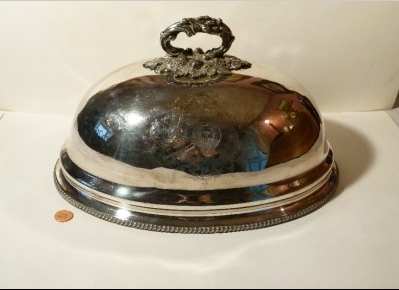 newsletter # 98 July 2012
newsletter # 98 July 2012www.ASCASonline.org SITE MAP
email: silverassociation@yahoo.it
YOUR GUIDE TO JULY NEWSLETTER:
articles
new
members
members' window
|
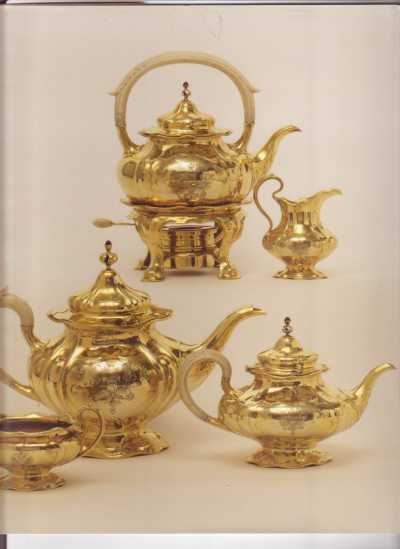
Dorothea Burstyn presents:
|
New members
Welcome to new ASCAS members:
Dan Free - USA
John Houmoller - England UK
Lindsay Jones - USA
Egert Klaas - Estonia
Elena Matukhina - Russia
Christopher Murphy - USA
|
top page -
page map |
Members' Window # 98
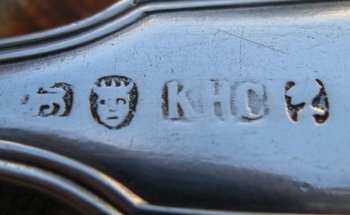
Alan Yates presents:
|
Mail to ASCAS: e-mail silverassociation@yahoo.it
Leslie Koelsch writes:
...Could you identify a silver mark, IDG, on this Portuguese
Toothpick, circa 1840-50?
It measures 7 1/2" high x 3" square at the base. The weight is
7.86 troy ounces. I purchased it from a dealer from Arizona who
had no idea what it was. A local silver expert told me that it
was Portuguese, and I have since researched it and noted the
examples in your site.
This one is not listed, however, but it's very similar to some
illustrated in your website.
Thank you.
Leslie Koelsch
***ANSWER PUBLISHED IN AUGUST 2012 NEWSLETTER***
John Strynkowski writes:
... As a member for 5 years, I have always enjoyed the reader's
questions, but this is the first question I have submitted
myself!!
I hope you or the other members can help me.
This partial gilt pedestal centerpiece has 4 marks. The German
crown and moon, 800, and what appears to be the silversmith's
name, and a tiny touchmark. I have difficulty reading the old
gothic print, but believe the name to be Ch. Beden. To the left
of the name is a very small six sided mark with an AI in the
center and a tiny B to the upper left of the A.
Any information about this silversmith would be appreciated.
Thank you,
John Strynkowski
***ANSWER PUBLISHED IN AUGUST 2012 NEWSLETTER***
The little six sides mark is the Austrian import mark
used in the period 1891-1901. Any information about the maker
will be welcome.
Giorgio Busetto
In Newsletter # 24 I presented the images of ancient
silversmith's tools from Planche V 'Outils' of L'Encyclopèdie
Diderot & D'Alambert and the corresponding 'legend'
containing the French name of each tool.
I was unable to offer a proper English translation of the page
and help of ASCAS readers was requested.
A mail received by Donald Whitney answers to my request of
assistance.
Giorgio Busetto
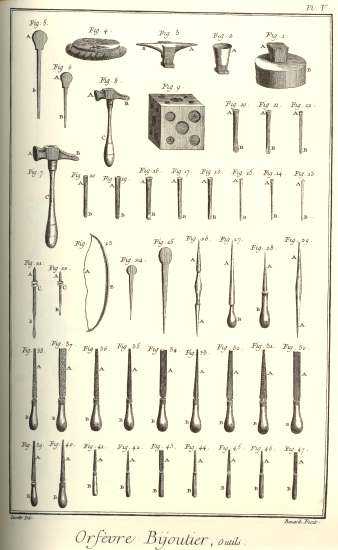
|
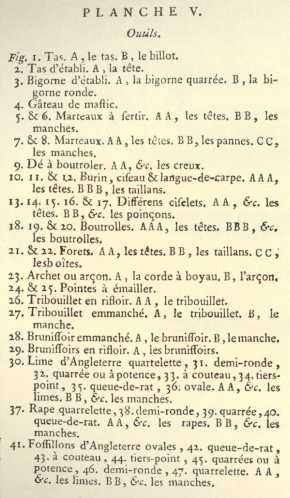
|
Donald Whitney writes:
Giorgio, I'm just finishing up intermediate silversmithing at my
local Gem & Mineral club, and can identify what a number of
these items are:
Fig 2: flat faced metal anvil, as for riveting
Fig 3: jeweler's anvil
Fig 4: could be a chasing bag - a leather bag filled with steel
shot and sewn shut used for Chasing & Repousse'. If this is the
case then the thick part on top is to rest the piece on while
striking it with chasing tools (sometimes used in place of a
pitch pot).
Fig 7, 8: small and large hammers
Fig 9: dapping block
Fig 10-12: burin (punch of some sort - notice the wide end for
striking with a hammer)
Fig 13-17: cifelets (punch of some sort - notice the wide end
for striking with a hammer)
Fig 18-20: boutrolles (punch of some sort - notice the wide end
for striking with a hammer)
Not sure about the Forets - Fig 20 & 21
Not sure about the purpose of Fig 23: Arcet o arcons
Fig 24-25: Pointes a emailler (Awl/Graver)
Fig 26: riffler file
Figures 30-47 are files (37 and 31 are actually rasps - very
coarse files)
The B items in 30-47 and 27-28 are handles.
Looking at this makes me really appreciate modern online jewelry
tool catalogs. When including a punch/stamp, they will often
include not only a picture of the tool but also a close-up of
the shape that is produced by that punch/stamp.
Please note that when these were included in the catalog, these
were state-of-the-art for 18th century France.
Hope this helps.
Donald Whitney
Replies to questions
Benedict Gagelmann
receives this answer about his silver teapot
(see June 2012 Newsletter)
Christophe Ginter writes:... regarding Benedict's request:
Swiss made, town Bern, end of 19th century. The silversmith is
presumably Pochon Frères.
The mark at the bottom indicates the silver content.
Christophe Ginter
Maurice R. Meslans
receives this answer about his silver wine tester
(see June 2012 Newsletter)
Robert Massart writes:... As Maurice R. Meslans states himself the guarantee mark does not
look like a Strasbourg mark 65 (see attached picture of a
Strasbourg mark 65).
The guarantee mark is the punch 35 for the department
Indre-et-Loire, city of Tours. I also added a picture of a
guarantee mark 35 of Tours to compare it with the picture of the
mark on the wine taster.
Robert Massart
"A PAGE per MONTH"
In this column we present a page obtained from makers'
brochures, books, auction catalogs, advertising or whatever
other printed paper, related to silver, that may be of interest
for ASCAS members.
The images will be published at a "low resolution" level and for
private and personal use only
"A WORD per MONTH"
In this column we
present an abstract from a page of the "What is? Silver
Dictionary"
courtesy of



|
MARKS ON SILVER IMPORTED IN THE UK FROM 1867 TO 1998The Custom Act of 1842 ordered that imported gold
and silver couldn't be sold in Great Britain and Ireland
unless it had been assayed at a British Office.
|
"A SILVERSMITH per MONTH"
In this column
we present marks, information and history of silversmiths and
silver manufacturers.
This column is published under the kind permission of Giorgio
Busetto's website

SIBRAY, HALL & CO LTDThe firm was founded in
Sheffield by Frederick Sibray and Job Frank Hall and was
active as manufacturing silversmiths and electroplaters
at Fitzwalter Works, 111 St Mary's Road and in its
London showrooms at 30 Ely Place, Holborn (c. 1890).
|
"A CREST per MONTH"
In this column we present images and descriptions of Crests and Mottoes of British, Irish and Scottish families as engraved on silver items.

Custom Search
Closing our July 2012 edition of ASCAS Newsletter I hope you have appreciated its content.
Your comments, suggestions and advice will be of great help.
My thanks to Dorothea Burstyn, Christophe Ginter, Leslie Koelsch, Robert Massart, John Strynkowski, Donald Whitney and Alan Yates for their invaluable contributions.
Giorgio Busetto
Secretary
ASCAS is a community of people having a common
interest in antique silver.
|

